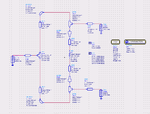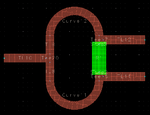luckyali
Member level 5
Dear sir, thats exactly what i did, i have used the LineCalc to find the length and width of the microstrip lines for 50 ohm and for 70.07 ohm. i keep the 50 ohm lines constant and the resister is fixed. i am only varying the length and width of the quarter wave line.the width of the Mbend is kept the same as width of quarterwave line.
the online thing i dont know waht effect it could bring is the microstrip line from between Tee's used to connect the resistor...
my schematic and layout looks as follow.


but unfortunately i am unable to tune this circuit for 20 Ghz, i also set optimization Goals but even they did not provide some good results.
there come a clash between schematic and layout design. some time when schematic gives good results, the length and width of lines are often annoying, sometimes they overlap bcoz of extra length or sometimes bcoz of short length, there is a big gap even to set the resister to its place...
i know that the variation in length and width of quaterwave can hit the spot but the thing annoying me is even this thing does'nt helps...


the online thing i dont know waht effect it could bring is the microstrip line from between Tee's used to connect the resistor...
my schematic and layout looks as follow.


but unfortunately i am unable to tune this circuit for 20 Ghz, i also set optimization Goals but even they did not provide some good results.
there come a clash between schematic and layout design. some time when schematic gives good results, the length and width of lines are often annoying, sometimes they overlap bcoz of extra length or sometimes bcoz of short length, there is a big gap even to set the resister to its place...
i know that the variation in length and width of quaterwave can hit the spot but the thing annoying me is even this thing does'nt helps...